From Kuching, Eileen and I flew to Auckland for our second trip to New Zealand this year. This time, it was mostly for work: I was there to attend the annual conference of the Society for Conservation Biology. You can't go to New Zealand for work alone, though, and this time we had an ulterior motive for travelling about a bit: we were taking our grandson Ryan, fast approaching his fifth birthday, with us - both for the pleasure of it and to give his mother, who was expecting at the time, a bit of a break). Ryan proved to be an excellent traveller, and thoroughly enjoyed himself.
On my first day (December 3, 2011), though, I abandoned Eileen and Ryan for a personal indulgence - a day-long trip out onto Hauraki Gulf with Pterodroma Pelagics in search of its rich diversity of seabirds.
On my first day (December 3, 2011), though, I abandoned Eileen and Ryan for a personal indulgence - a day-long trip out onto Hauraki Gulf with Pterodroma Pelagics in search of its rich diversity of seabirds.
This was a special trip, laid on at a discount for SCB members, and I was delighted to be able to go along - especially as I had been unable to join a similar trip on my earlier visit in March. I rode up to Ti Point Wharf on Whangateau Harbour with Dr Jocelyn Aycrigg of the University of Idaho (that's Dr. Aycrigg with the backpack), who (given her academic venue) doesn't get to see seabirds very often.
Begore we set out, I took the opportunty to photograph the flowers of a Pōhutukawa (Metrosideros excelsa) blooming by the shore. Though Pōhutukawas are planted widely in New Zealand they are native only to the northern portion of the North Island, where their flowering peak in from November through January (it is often called the New Zealand Christmas Tree).
Our gang of birders assembled, we were on our way out of the harbour and into the open waters of the gulf.
Hauraki Gulf is one of the richest seabird areas in New Zealand, and islands wthin its waters are the sole or primary breeding grounds for seveal species. We had not long to wait for the proof of this statement: the first of two enormous shoals, concentrating over equally enormous shoals of large fishes feeding in the surface waters. This one was composed almost entirely of Buller's Shearwaters (Puffinus bulleri), a species that ranges over much of the Pacific but breeds almost exclusively on the Poor Knights Islands in the northern part of the gulf. Though there may be over two million of them, their tiny breeding range has led Birdlife International to classify the species as Vulnerable.
In with the shearwaters were Cook's Petrels (Pterodroma cookii) (the bird dead centre in this photo) and Flesh-footed Shearwaters (Puffinus carneipes) (the all-dark bird to its left).
Hauraki Gulf is one of the richest seabird areas in New Zealand, and islands wthin its waters are the sole or primary breeding grounds for seveal species. We had not long to wait for the proof of this statement: the first of two enormous shoals, concentrating over equally enormous shoals of large fishes feeding in the surface waters. This one was composed almost entirely of Buller's Shearwaters (Puffinus bulleri), a species that ranges over much of the Pacific but breeds almost exclusively on the Poor Knights Islands in the northern part of the gulf. Though there may be over two million of them, their tiny breeding range has led Birdlife International to classify the species as Vulnerable.
In with the shearwaters were Cook's Petrels (Pterodroma cookii) (the bird dead centre in this photo) and Flesh-footed Shearwaters (Puffinus carneipes) (the all-dark bird to its left).
We found our second shoal off a pair of rocky islets, feeding excitedly over a boiling mass of fishes.
It was more of a mixed bag, but was also dominated by a single species, the Fairy Prion (Pachyptila turtur), a species - unlike Buller's Shearwater - with a wide breeding range across the southern oceans.
It was more of a mixed bag, but was also dominated by a single species, the Fairy Prion (Pachyptila turtur), a species - unlike Buller's Shearwater - with a wide breeding range across the southern oceans.
Buller's Shearwaters and Red-billed Gulls (Chroicocephalus scopulinus) joined the prions in the feeding bonanza.
When our boat drew close enough, we could see, and even, in a few cases, identify the fishes hunting beneath them.
Most of these are Silver Trevally or Araara (Pseudocaranx georgianus), a member of the jack family (Carangidae) and a common, though heavily-fished, schooling fish in the gulf.
The speckled back of the fish in the foreground marks it as a Kahawai or Sea Trout (Arripis trutta). Despite its name (and its alternate name, Eastern Australian Salmon) it is not a member of, or even closely related to, the trout and salmon family (Salmonidae). Instead, it is a member of a tiny family of only four species, the Arripidae, confined to southern Australia, New Zealand and nearby waters.
Tiny islets scattered throughout the gulf provide roosting and breeding sites for seabirds. This one held a colony of Red-billed Gulls (Chroicocephalus scopulinus), with a scattering of White-fronted Terns (Sterna striata).
These elevated stacks - three of the five Maori or Cathedral Rocks, part of the Mokohinau Islands - form pat of a nature reserve.
The largest of them holds a colony of Australian Gannets (Morus serrator) that we were content to watch from a distance.
Our target was the smallest, an impressive pile in itself; but our interest was a seabird at the very southern extremity of its breeding range.
The Grey Ternlet or Grey Noddy (Procelsterna albivitta) is a tropical and subtropical Pacific species that breeds in numbers on the Kermadecs to the north (and ranges as far east as Easter Island). Only a few scattered pairs reach Hauraki Gulf.
It is a pearly-grey little bird, particularly graceful and attractive. It was once considered to be merely a colour form of the more tropical Blue Noddy (Procelsterna cerulea), but the two are usually considered separate species today.
For our lunch stop we pulled into the shelter of the main Mokohinau Islands, where we listened while we ate to the shrill cries of Red-crowned Parakeets (Cyanorhamphus novaeseelandiae).
Birds were not the only creatures we found in the gulf. This might be a Cyanea, a large pelagic jelly found almost worldwide (the identification of the New Zealand species is uncertain), but I am far from sure.
One of the standard techniques for getting good looks at pelagic seabirds is to toss over some chum - fish guts, for example. Petrels and their relatives, unlike some other birds, have a keen sense of smell and can respond with alacrity to a particularly juicy tidbit. Of course, so can other things.
In this case, our chum bag attracted a half-dozen or so Bronze Whalers (Carcharhinus brachyurus). The Bronze Whaler or Copper Shark is the only member of the genus Carcharhinus in the temperate zone, where it has a rather patchy distribution in both hemispheres.
Like many sharks, it has more to fear from us than we from it; it has been overfished, and IUCN has recently reclassified it as Near Threatened (though the populations off Australia and New Zealand still appear to be in good shape).
In my next few posts I will look at the seabirds in more detail, so stay tuned!



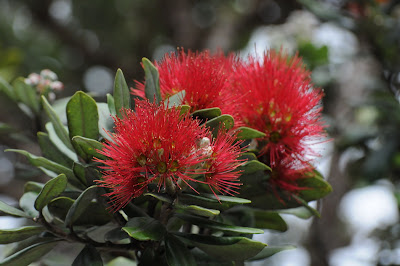


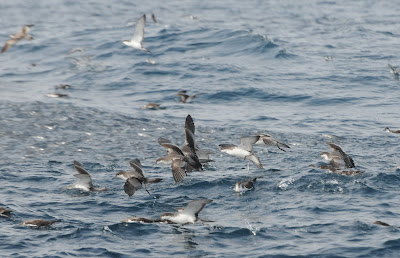






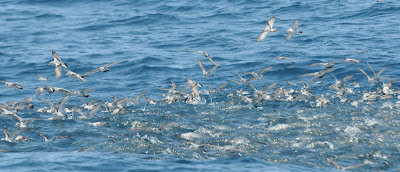
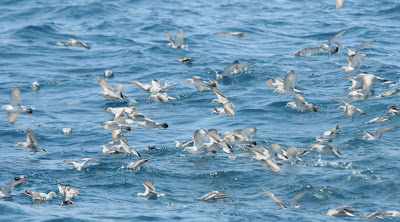






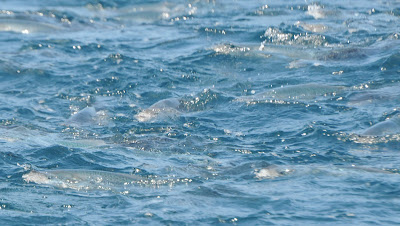



















No comments:
Post a Comment